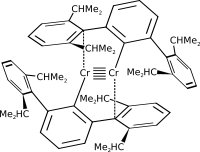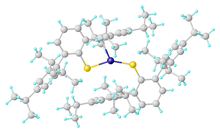Philip Power
Philip P. Power, is Distinguished Professor of Chemistry at the University of California, Davis. He has contributed to the synthesis, structure, and physical and chemical characterization of inorganic and organometallic compounds. His research focuses on low-coordinate main group and transition metal compounds. Much of this work hinges on the use of sterically crowded ligands to stabilize unusual geometries.

The structure of [CrC6H3-2,6-(C6H3-2,6-(iPr)2)2]2 prepared by Power et al.[1]
Education
Philip Power obtained a B.A. from University of Dublin in 1974 and a Ph.D. from University of Sussex in 1977 (under M.F. Lappert). He was a postdoctoral coworker under R .H. Holm at Stanford University (1978–1980). In 1981 he was appointed to the faculty of UC Davis, where he is Distinguished Professor.

Structure of the quasi-two-coordinate ferrous dithiolate Fe[SC6H3-2,6-(C6H2-2,4,6-(iPr)3)2]2. A weak Fe-C(ipso) bond is indicated by the Fe---C distance of 2.427(1) Å. The structure illustrates the low coordination numbers enabled by bulky ligands.[2]
Awards
- Alexander von Humboldt Award, 1992
- Faculty Research Lecturer, University of Iowa, 1993
- Distinguished Visiting Professor, University of Auckland, New Zealand, 1993
- Reilly Lectureship, University of Notre Dame, 1995
- Werner Lectureship, Trinity College Dublin, 1996
- Membership of Editorial Advisory Board of Organometallics, Inorganic Chemistry, Dalton Transactions, Canadian Journal of Chemistry, Heteroatom Chemistry, Journal of Organometallic Chemistry, Polyhedron
- Ludwig Mond Award Royal Society of Chemistry, 2004
- Associate Editor, Inorganic Chemistry, 2004
- Sloan Foundation Fellow, 1985–1989
- F. A. Cotton Award in Synthetic Inorganic Chemistry, American Chemical Society, 2005
- Fellow of the Royal Society, 2005
- ACS Award in Organometallic Chemistry, 2011
External links
References
- ↑ Nguyen, Tailuan; Sutton, Andrew D.; Brynda, Marcin; Fettinger, James C.; Long, Gary J.; Power, Philip P. (2005). "Synthesis of a Stable Compound with Fivefold Bonding Between Two Chromium(I) Centers". Science. 310 (5749): 844–847. Bibcode:2005Sci...310..844N. doi:10.1126/science.1116789. PMID 16179432.
- ↑ Nguyen, T.; Panda, A.; Olmstead, M. M.; Richards, A. F.; Stender, M.; Brynda, M.; Power, P. P. (2005). "Synthesis and Characterization of Quasi-Two-Coordinate Transition Metal Dithiolates M(SAr)2 (M = Cr, Mn, Fe, Co, Ni, Zn; Ar = C6H3-2,6(C6H2-2,4,6-Pri3)2)". J. Am. Chem. Soc. 127: 8545–8552. doi:10.1021/ja042958q.
This article is issued from
Wikipedia.
The text is licensed under Creative Commons - Attribution - Sharealike.
Additional terms may apply for the media files.